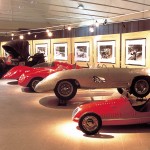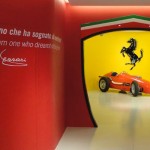Are you fond of vintage car? Here's a place you can't miss
Vintage car passion: The Panini Museum
Discover its unique collection of rare vintage Maserati
Are you fond of vintage cars? In Italy you can find a long itinerary called “Motor Valley” which runs along the plain and cuts across the Via Emilia, in the north of Italy, which is full of veritable temples of vintage cars.
For example the Panini Museum, which shows an unique collection of vintage and classic vehicles and motorcycles, included a collection of some of the most important Maseratis in the world. How did the Italian city of Modena end up being the motor capital of Italy and of the entire world?
Visit Panini Car Museum official website
Video Full Text: The Panini Museum
The Motor Valley runs along the plain and cuts across the Via Emilia.
We’re on the Hombre farm.
Three hundred and thirty hectares for five hundred cows, managed by the young farm worker, Matteo Panini.
He is the son of Umberto who, along with his brothers Benito, Franco and Giuseppe, invented the Panini trading cards.
A family of farmers who also cultivated a passion for motor vehicles.
So how did Modena end up being the motor capital of Italy?
The explanation lies in its link with the land:
once upon a time cows, horses and men used to work the land.
Then with the invention of steam engines and internal combustion engines, the tractor was born!
In an instant Modena was transformed into a farming and engineering reality.
This brought with it the figure of the metal-mezzadro, i.e. the farmer turned factory-worker who works both with his hands and with all things mechanical.
The Panini collection of motorcycles and cars started with tractors.
This is a working Superlandini tractor from 1934.
The history of motor vehicles begins here, with the tractor.
These vintage and classic vehicles are the centre piece of Matteo Panini’s collection.
There are three themes: one is a collection of some of the most important Maseratis in the world.
Then we have the cars collected by Umberto Panini and finally around one hundred motorcycles.
We’re going up to the second floor of the Panini Museum.
Here we find a huge photo of Alfieri Maserati in 1926, on board the first ever Maserati.
It is in these faces that you see the true mechanical pride.
These gentlemen didn’t have a penny to their name and yet they challenged figures such as Bugatti;
they pitted themselves against Alfa Romeo and Mercedes, who were building cars for Mussolini and Hitler.
They set out from Bologna to challenge the giants of motor manufacturing.
This was the bicycle of the Bersaglieri regiment!
It’s a modern mountain bike: it has a rear shock absorber and it folds away.
Whoever invented it must have said to themselves: “this must never break”!
A great deal of practicality went into designing things in the past.
The second floor is where we find the motorcycles.
A Guzzino! When I was a child my grandfather used to let me ride pillion on the back of his.
Here’s the Formichino, dating from 1955 – 56, and then a Ducati.
This is a Cruzer, a very rare machine designed by Ghia.
The Galletto was the priest’s motorcycle because it could be ridden whilst wearing a cassock.
The Lambretta, Vespa and the Delfino Motom.
An Acquilotto – my mum, who was a teacher, used to drive one of these to get to school.
There is one common link in the relationship between motor vehicles and the land – the farm.
It’s the dynamic part of this passion.
Five hundred cows producing twelve wheels of organic Parmigiano Reggiano every day.
So what do motorcycles, cars and wheels of Parmigiano have in common?
It’s in the sound! A firm sound!
Mechanics is always in there somewhere.
Every hammer has a different weight and gives different sensations and vibrations.
Yes, that’s just it; we modify hammers on this land as well!














